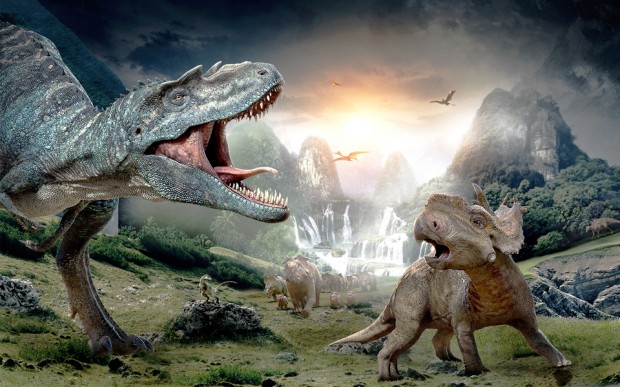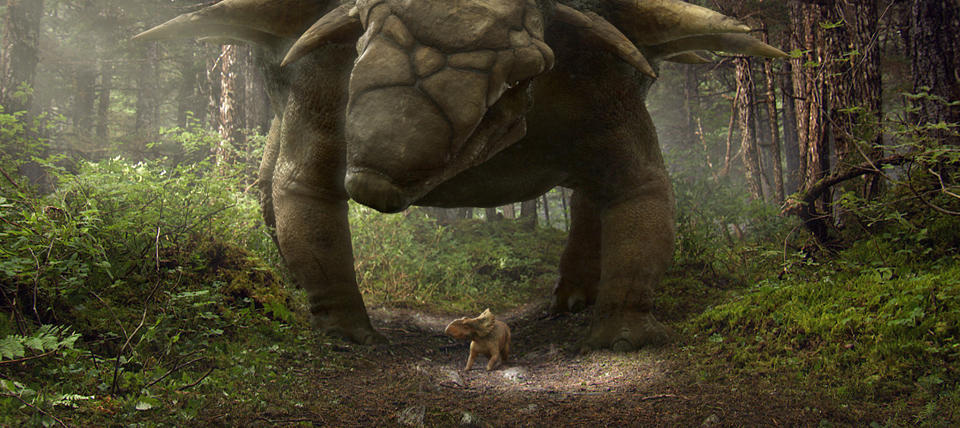
Walking with Dinosaurs puts a family feature spin on BBC’s acclaimed CG-animated documentaries about the Jurassic giants.
Audiences have had a love affair with animated dinosaurs ever since Winsor McCay brought Gertie to the big screen in his seminal 1914 toon. Since then, the Jurassic creatures have played a huge part in the pop culture landscapes, starring in favorite TV toons such as The Flintstones and Dinosaur Train and beloved movies such as Don Bluth’s The Land Before Time series, Disney’s Dinosaur and Steven Spielberg’s Jurassic Park. This month, a Pachyrhinosaurus clan will steal the limelight in Walking with Dinosaurs, a family reboot of the BBC documentary project, directed by industry veterans Neil Nightingale and Barry Cook.
Written by John Collee (Happy Feet, Master and Commander), the film features CG-animated dinosaurs in live-action settings filmed in Alaska and New Zealand, which were chosen for their similarity to the creatures’ original habitats from the late Cretaceous period, about 70 million years ago. The pic is narrated by an Alexornis bird name Alex (voiced by John Leguizamo) and follows the adventures of the Pachyrhinosaurus trio of Patchi, Scowler and Juniper as they grow up, migrate and fight an evil predator called Gorgon the Gorgosaurus!
Barry Cook, the director of Disney’s Mulan and co-director of Sony/Aardman’s Arthur Christmas, tells us that he jumped at the opportunity of working on the movie because it allowed him to work on a pic that combines CG animation against live-action backdrops, something that he hadn’t experienced before. “You always need to grow in your career, and I felt it allowed me to take the next step in my career,” says the director. “It also allowed me to get together with the original screenwriter John Collee and put our heads together to tell the best story possible.”
Cook, who began working on the film in March of 2010, says the project had a rocky start since it went through many changes during early development. Originally inspired by a straight-forward BBC documentary series, the movie was conceived as a silent movie—with no dialogue or narration. “It was supposed to have a little bit of score and the sound of the dinosaurs,” says the director. “Coming out of animation and visual storytelling, I knew how to put shoots together and tell a story visually. I think originally, we were looking at a film that could stand alone as a virtual silent movie … You can turn the soundtrack off and still get involved with the story and feel the emotions of the characters. In its final version, the movie has a narration and goes inside the heads of the animals, so you can hear what they’re thinking.”
The feature, which also includes a live-action, modern-day framing device, ended up requiring 800 animated shots, which were produced by Sydney-based Animal Logic (Happy Feet, Guardians of Ga’Hoole), via the studio’s Softimage pipeline. “That’s actually a really low number for an animated film of any kind,” notes Cook. “In the end, the narration ended up adding more emotion and humor to the film. Alex is a funny character, and the film may remind you of family classics like Homeward Bound: An Incredible Journey.”
For Cook, one of the most beautiful moments in the film is the end of the second act. “Our hero, Patchi has hit the bottom of his life,” says the helmer. “You don’t know if he is going to survive. From a production design standpoint, it’s beautifully imagined. It’s night in the forest, and he’s been trapped, and the camera movement captures the quiet emotional power of the scene.” He also praises many of the comedic elements of the pic. “There’s some very funny stuff when Alex is dueling with the crabs on the beach. After all, any story that deals with animals will showcase strictly physical humor. That’s a given.”
The stereoscopic 3-D aspects of the movie also created their own set of challenges for the creative team. Cook points out that with the exception of a couple of sequences which feature CG environments (including a frozen lake where Patchi and his brother have a big fight), the rest of the movie features live-action footage. “When you’re shooting in 3-D, every shot requires two camera set-ups put together, so, potentially, a lot can go wrong. Fortunately, we had Cameron Pace Group on board as stereographers and consultants and our cinematographer John Brooks was part of that group. Then, of course, we had to come back and get the characters to work in those environments. But when you see the final version, it feels like we filmed the dinosaurs like they’re against their natural world.”
Cooke, who started out his career at Hanna-Barbera studios as an assistant animator and worked on the first pilot episode of The Smurfs, says he is thrilled with the changes and innovations that the new tools have brought to the business. “It’s great to embrace these new tools, because they allow directors and storytellers to bring their visions to dynamic life. That’s why I embraced the shift from 2D to CG and now to this stereoscopic format.”
Drawing Dino
Lifelong dinosaur enthusiast David Krentz says working on the movie as a character designer was also a dream come true. “I’m a total dinosaur nerd, so when I got the offer to work on the movie, I felt like a kid in a candy store.” Krentz, a veteran of features such as Disney’s Dinosaur, Fantasia 2000, Treasure Planet, John Carter and Escape to Planet Earth, says what really excited him about the project was its initial commitment to realism. “I loved the fact that I had to answer to five or six paleontologists when I was designing the characters. The fact that I managed to please all of them was a great feat.”
Krentz remembers that he was working on Disney’s Dinosaur movie when BBC’s dino series hit the small screen. He believes that you can actually watch Walking with Dinosaurs without the added narration and animal voiceovers! “Although the production veered away from being very realistic, the animation still plays independently,” he insists. “The powers that be decided to add narration and voice-over to reach a wider audience and the characters became slightly anthropomorphized to make them more attractive to younger kids.”
The character designer, who conceived close to 20 Jurassic creatures for the movie, began his assignments by first drawing them in pencil. “I did those pencil sketches, and then worked closely with the scientists to hit the right balance between realism and caricature,” he recalls. “Then I used ZBrush to sculpt the characters since I didn’t want to deal with popular mesh topology—that’s why ZBrush is so handy.” (Mesh topology is a type of networking where each node must not only capture and disseminate its own data, but also serve as a relay for other nodes.) Those CG models would then go to animation.
So how are this movie’s 2013 dinos different from the ones he created in years past? “These creatures have great muscle systems, their skin is beautiful, they have beautifully rendered feathers—the level of realism has been upped. You can get extra layers of grit and dirt computationally—and it all adds up,” he responds. “I directed a show called Dinosaur Revolution and a feature called Dinotasia, and I could have really used these new tools back then! I had to digital sculpt 70 dinosaurs for that show and we had to do with a lot less.”
Krentz, who was animating dinosaurs even back when he was a student at CalArts, says his biggest challenge on this movie was walking that tightrope between realism and caricature. “When we started out on the project, it leaned towards realism, but then we had to make it more cartoony. For the first time in my career, I had scientists advise me to make the eyes bigger on the juveniles!”
Not only did he get to mix his personal passion with his job on the movie, he also gets to share his work with his kids for the first time. “This will be the first film I can actually bring my kids to see in a theater with me,” says Krentz with a laugh. “My five-year-old is just as dino-obsessed as I am!”
Fox will release Walking with Dinosaurs in U.S. theaters on December 20.























 Win a Funko X Lilo & Stitch Prize Pack!
Win a Funko X Lilo & Stitch Prize Pack! 


